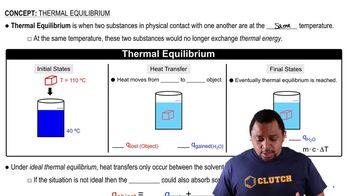Here are the essential concepts you must grasp in order to answer the question correctly.
Reaction Rates
Reaction rates refer to the speed at which reactants are converted into products in a chemical reaction. In this case, the forward reaction rate is 18 M/s, while the reverse reaction rate is 12 M/s. Understanding these rates is crucial for determining the direction in which the reaction will proceed to reach equilibrium.
Recommended video:
Equilibrium
Chemical equilibrium occurs when the rates of the forward and reverse reactions are equal, resulting in constant concentrations of reactants and products. In this scenario, since the forward reaction rate (18 M/s) is greater than the reverse reaction rate (12 M/s), the system is not at equilibrium and will shift towards the formation of more products to achieve balance.
Recommended video:
Le Chatelier's Principle
Le Chatelier's Principle states that if a system at equilibrium is disturbed, it will adjust to counteract the disturbance and restore a new equilibrium. In this case, since the forward reaction is faster, the system will favor the forward direction to increase the concentration of products (AB) until the rates of both reactions equalize.
Recommended video:





